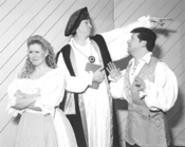This musical, born in 1956, has reached its full potential only once -- in its superb original cast album. Unlike the eminently stageworthy musicals of Rodgers and Hammerstein, Candide is almost impossible to smoothly stage. Its unwieldy mix of mayhem and enchantment has baffled audiences for decades.
The show is based on Voltaire's 1757 novelistic indictment of philosophers who preach false optimism. More than two centuries later, the novel still gives French students subversive pleasures and raises the hackles of church and state. A breathless picaresque, in the manner of Tom Jones, it concerns the frantic adventures of the titular German youth, who loves the narcissistic princess Cunegonde and is in constant bloody conflict over her honor with her proud, vain brother Maximilian.
Tutor Pangloss is the ultimate insane optimist. His motto is "There is a reason for everything under the sun." He claims that everything is for the good, and that this is the best of all possible worlds. Proving him wrong, the characters pass through a multitude of 18th-century cataclysms. Every scene offers some new form of annihilation, including vicious kidnapping pirates, the tortures of the Inquisition, multiple rapes, and every kind of moral turpitude. The story takes its haphazard characters on a trip around the then-known world. Eventually back where they started, the chastened Candide and cohorts learn to "tend their own gardens."
Here is a musical that emerged as a sepulcher forged by two warring theater gods. Bookwriter Lillian Hellman wanted it to be a play with a little bit of music; composer Bernstein wanted it to be an opera parody with a little bit of book. Hellman was determined to mold Voltaire's parable into an allegory about the evils of McCarthyism. Her dark, trenchant script portrays a hellish world that no musical whitewash can make less horrific. Bernstein, the effortless Fred Astaire of the classical music world, wanted to spoof the pyrotechnics of grand opera. He wrote a score so full of the joy of life and music that it surpasses what it is supposed to be spoofing. It is the ultimate musical exultation of a genius extrovert.
The playwright and the composer managed a one-of-a-kind compromise. Its sheer defiance of the rhinestone boas and valentines of past musicals opened a future where anything was possible, from the operatic slayings of Sweeney Todd to a singing and dancing extravaganza about the sinking of the Titanic.
Brilliance and success don't always make happy bedfellows. Candide, with only 73 performances chalked up on Broadway, was reckoned a failure. Its epic production was likened by one critic to an "enormous splendid pastry at the center of which is a hard, bitter pit."
Hellman resented Bernstein getting the attention and the praise, while she got the scorn; she withdrew her book, taking away that "bitter pit." Another writer, Hugh Wheeler, replaced Hellman's vivifying venom with classic comic book antics. With this sad rewrite, Bernstein's flawless musical gems became incongruous. Using an army of lyricists, the composer kept on trying to repair the damage with new songs. These made for some fascinating new recordings, but kept needlessly inflating the show. After five rewrites, including some bilious singing sheep, Candide enters the 21st century dangerously heading toward Disneyland.
Even working with one of these distorted rewrites, Tri-C manages to create a surprisingly merry olde carnival. The orchestra, unfortunately, begins the merriment with a rendition of the musical's magnificent overture, which sounds like two Volkswagens in a head-on collision.
However, after the musical carnage is cleared away, there is much to savor. Director Kira Seaton and choreographer G.E. Urdaneta have managed to recruit a wagonful of zesty, high-spirited performers. The cast comports itself like bawdy 18th-century illustrations brought to leering life.
Halfway between concert and full staging, the production has the engaging air of rapscallions glorying in their naughtiness. Among the unforgettable images is Beth O. Cubbison as Cunegonde, trilling the magnificent coloratura ode to girlish hypocrisy "Glitter and Be Gay." Bemoaning her lost virtue while simultaneously plundering the pianist's jewelry, she gleams like a gypsy hellcat let loose. Then there is R. Scott Posey's Candide, who looks like an imp and sings like a dream. Making a wondrous paradox worthy of Gilbert and Sullivan is Lawrence Nehring's pretentious Dr. Pangloss, making witty overtures to Laura Held-Posey's delightful tease of a Paquette.
Like its distressed lovers, Candide is a work that has been repeatedly pillaged, yet it remains an ode to high spirits.


